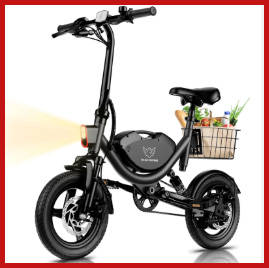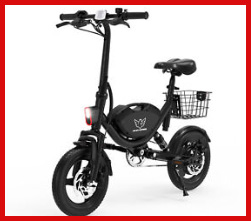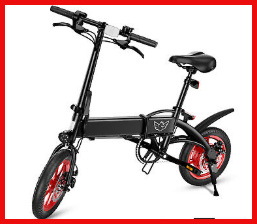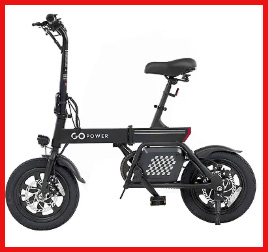Picture this: zipping through city streets, breeze in your hair, no sweat on your brow, and a grin that just won’t quit. That’s been my reality since I got my hands on a Windhorse electric bike. If you’re hunting for a ride that’s practical, fun, and eco-friendly, I’m here to tell you why the Windhorse is worth every penny. From daily commutes to weekend adventures, this bike has transformed how I move. Let me take you through my experience, the good, the bad, and how to make the most of it—because trust me, you’ll want one too.
My Journey With The Windhorse Electric Bike

I’ve been riding the Windhorse W3 Urban Commuter for six months now, clocking over 1,500 miles through city traffic, park trails, and even some rainy days. As someone who’s ditched the car for shorter trips, I needed a bike that could keep up with my lifestyle—reliable, easy to handle, and budget-friendly. The Windhorse delivered, but it’s not just about the ride; it’s about the freedom and joy it brings. Whether you’re a daily commuter or a casual rider, here’s why this bike has my heart—and why it might steal yours too.
What I Love About The Windhorse (The Pros)
The Windhorse W3 has been a game-changer, and I’m not just saying that because I’m a fan of two-wheeled adventures. Here’s what makes it stand out:
Read More: My Thought on Aventon Vs. Pedego Ebikes
- Affordable Price Point: At under $1,000, the Windhorse W3 offers premium features without breaking the bank. It’s a steal compared to pricier brands like Specialized or Trek, making it accessible for budget-conscious riders like me.
- Impressive Range: With a 288Wh battery, I get 22-35 miles per charge. That’s enough for my daily commute and weekend errands without worrying about running out of juice.
- Lightweight Design: Weighing just 45 lbs, this carbon alloy frame is easy to carry up stairs or stow in my apartment. It’s a lifesaver for urban dwellers with limited space.
- Smooth Acceleration: The 450W brushless hub motor (peaking at 680W) delivers seamless power. Whether I’m climbing a hill or weaving through traffic, it feels effortless.
- Compact and Foldable: The folding design (11785971021mm) makes storage a breeze. I can tuck it into a closet or even take it on public transport.
- Quick Charging: The battery recharges in 4-5 hours, so I’m never stuck waiting. I plug it in overnight, and it’s ready for my morning ride.
- Durable Build: After 1,500 miles, including some wet rides, the frame and components are holding up like champs. The welds are clean, and it feels solid.
- Comfortable Ride: The 14-inch tires and ergonomic saddle make long rides a joy. My back and butt thank me after hours on the road.
- Easy Assembly: It arrived 95% assembled, and the included manual made setup a 15-minute task. Even if you’re not a bike pro, you’ll manage.
- Warranty and Support: The 1-year warranty and responsive online support give me peace of mind. I haven’t needed it yet, but it’s nice to know it’s there.
The affordability and range are what sold me initially. I was skeptical about getting a quality e-bike for under a grand, but the Windhorse W3 proved me wrong. The lightweight frame is a godsend for my third-floor walk-up, and the folding feature means I can store it without sacrificing half my living room. The motor’s power makes hills feel like flat roads, and the quick charging means I’m never stranded. It’s not just a bike—it’s a lifestyle upgrade.
The Not-So-Great Stuff (The Cons)
No bike is perfect, and the Windhorse has its quirks. Here’s what I’ve noticed after months of riding:

- Limited Top Speed: The 18 MPH cap is fine for city riding, but if you’re craving speed, it might feel restrictive compared to Class 3 bikes hitting 28 MPH.
- Basic Suspension: There’s no front suspension, so rough roads can feel jarring. I’ve gotten used to it, but it’s not ideal for gravel or bumpy trails.
- Smaller Tires: The 14-inch tires are great for maneuverability but less stable on uneven terrain than larger 20-inch or 26-inch options.
- Battery Range Variability: In cold weather or with heavy throttle use, the range dips closer to 20 miles. You’ll need to plan rides carefully in winter.
- No Integrated Lights: Unlike some competitors, it doesn’t come with built-in lights. I had to add my own for nighttime rides, which was an extra cost.
- Brake Adjustments Needed: Out of the box, the brakes needed tweaking. It was easy enough with the included tools, but it’s a minor hassle.
- Limited Color Options: You get black or silver—pretty standard. I’d love more vibrant choices to match my style.
- No Throttle Option: It’s pedal-assist only, which is great for exercise but limits flexibility compared to bikes with throttle modes.
- Handlebar Comfort: The grips are decent but not plush. Long rides can make my hands tingle, so I’m considering upgrading to ergonomic ones.
- Basic Display: The LCD is functional but bare-bones. It shows speed and battery life, but don’t expect fancy features like smartphone integration.
The speed cap and lack of suspension are the biggest drawbacks for me. If you’re sticking to smooth city streets, you won’t mind, but off-road enthusiasts might want more. The battery range drop in cold weather caught me off guard once, leaving me pedaling manually for the last mile. Adding lights was a small expense, but I wish they were standard. Still, these are minor gripes for the price—you get what you pay for, and then some.
Maintenance Tips To Keep Your Windhorse Rolling Smoothly
Owning an e-bike is like having a trusty steed—you’ve got to care for it to keep it galloping. Here’s how I keep my Windhorse in top shape:
- Check Tire Pressure Weekly: I keep tires at 40-50 PSI for optimal performance. Low pressure makes pedaling harder and risks flats.
- Clean and Lube the Chain: Every 100 miles, I wipe down the chain and apply bike-specific lubricant. It keeps shifts smooth and prevents rust.
- Inspect Brake Pads: I check brakes monthly for wear, especially since e-bikes are heavier. Replacing pads early avoids costly rotor damage.
- Charge Smartly: I avoid letting the battery drop below 20% and store it indoors during winter to maintain its lifespan.
- Tighten Bolts Regularly: Vibrations can loosen bolts, so I check the frame and handlebars every few weeks with a hex wrench.
- Keep It Dry: After rainy rides, I dry the bike thoroughly to prevent corrosion, especially around the motor and battery contacts.
- Monitor Battery Health: I charge at room temperature and avoid fast chargers to extend battery life. It’s still going strong after 1,500 miles.
- Clean the Frame: A quick wipe-down after rides keeps dirt from building up. I use a damp cloth and avoid high-pressure water near electronics.
- Store Properly: I keep it in a dry, cool place to protect the battery and frame. If you’re folding it, ensure the hinges are secure.
- Schedule Professional Tune-Ups: Every 500 miles, I take it to a local shop for a full check-up. It’s worth the cost for long-term reliability.
Maintaining the Windhorse is straightforward, especially if you’ve ever owned a regular bike. The chain and brakes need the most attention since the extra weight and speed of an e-bike wear them faster. I learned the hard way that skipping chain lube leads to creaky, sluggish rides. Storing the battery properly has kept it reliable, and regular cleaning makes it look as good as new. Treat it right, and it’ll treat you to years of smooth rides.
Getting The Most Out Of Your Windhorse
To make your Windhorse experience as awesome as mine, here are my top tips for maximizing performance and fun:

- Adjust Assist Levels: Use lower assist modes for flat terrain to save battery. I switch to high assist only for hills or headwinds.
- Plan Your Routes: Stick to bike lanes or smooth paths to avoid wear on tires and components. Apps like Komoot help find e-bike-friendly routes.
- Invest in Accessories: I added a rear rack and panniers for errands. A good lock and lights are must-haves for city riding.
- Practice Efficient Pedaling: Pedal smoothly to complement the motor. It extends range and makes rides feel more natural.
- Monitor Battery Usage: Check the display regularly to gauge remaining range. I always carry a charger for longer trips, just in case.
- Upgrade the Saddle: If you ride long distances, a cushier saddle can make a big difference. I swapped mine for a gel one, and it’s heaven.
- Join E-Bike Communities: Online forums like Reddit’s r/ebikes offer tips and hacks. I learned about tire upgrades from fellow riders.
- Ride in Good Weather: Wet rides are fine, but avoid heavy rain to protect the motor. I check forecasts before heading out.
- Use Proper Gear: A helmet and gloves make rides safer and comfier. I also wear padded shorts for extra cushioning.
- Track Your Rides: Apps like Strava let you log miles and monitor performance. It’s motivating to see your progress over time.
These tips have turned my Windhorse into a versatile beast. Adjusting assist levels stretched my range to 35 miles on a good day, and accessories like panniers made it my go-to for grocery runs. Joining e-bike groups online opened my eyes to tweaks I’d never considered, like swapping tires for better grip. It’s all about making the bike work for your life—whether you’re commuting or exploring.
Windhorse Vs. Other Brands: How It Stacks Up
I’ve test-ridden a few other e-bikes to see how the Windhorse compares. Here’s how it fares against popular brands like Lectric, Rad Power, Aventon, and Specialized:

- Windhorse vs. Lectric XP 4.0: The Lectric XP 4.0 is a folding bike like the Windhorse but offers a throttle and a 500W motor for $999. It’s heavier at 60 lbs, making it less portable, and its 20-inch tires feel bulkier. Windhorse wins for lightweight city commuting, but Lectric’s throttle is a perk for lazy days.
- Windhorse vs. Rad Power RadRunner: The RadRunner ($1,499) is a cargo beast with a 750W motor and 48V battery, ideal for heavy loads. Its range (25-45 miles) beats Windhorse, but it’s pricier and heavier (65 lbs). Windhorse is better for solo commuters on a budget.
- Windhorse vs. Aventon Aventure.2: Aventon’s fat-tire Aventure.2 ($1,899) is a powerhouse with a 750W motor and 28 MPH top speed. It’s great for off-road but overkill for city use. Windhorse’s affordability and compactness make it more practical for urban riders.
- Windhorse vs. Specialized Como: The Como ($2,800) is a premium commuter with a 530W motor and sleek design. Its 50-mile range and integrated lights are impressive, but the price is steep. Windhorse offers similar urban utility for a fraction of the cost.
- Windhorse vs. Ride1Up Roadster V3: The Roadster V3 ($1,095) is lightweight (33 lbs) with a 500W motor, but its 20-30 mile range is comparable to Windhorse. It’s pricier and lacks folding capability, giving Windhorse an edge for storage.
- Windhorse vs. Carrera Crossfuse: Halfords’ Carrera Crossfuse ($1,200) has a 250W Bosch motor and 40-mile range. It’s reliable but heavier (50 lbs) and less compact. Windhorse’s folding design and lower price make it more versatile.
- Windhorse vs. Hero Electric Flash: The Flash ($600) is cheaper but slower (15 MPH) with a 20-mile range. It’s less durable, and the Windhorse’s build quality and power make it a better long-term investment.
- Windhorse vs. Whyte RHe0 3: The Whyte ($2,000) is a hybrid with a 250Wh battery and off-road capability. It’s pricier and less portable, making Windhorse the go-to for city commuters.
- Windhorse vs. Cannondale Compact Neo: The Compact Neo ($1,900) is lightweight (40 lbs) with integrated lights, but its 250Wh battery offers less range. Windhorse’s affordability and folding feature give it an edge.
- Windhorse vs. Engwe P275 ST: The Engwe ($1,500) has a 500W motor and 40-mile range but is heavier (55 lbs). Windhorse’s compact design suits urban riders better.
The Windhorse holds its own against pricier brands by balancing cost, portability, and performance. If you need a throttle or off-road power, Lectric or Aventon might suit you better, but for city commuting on a budget, Windhorse is tough to beat. Its folding design and lightweight frame make it a practical choice for apartment dwellers like me.
Frequently Asked Questions (Faq)
It depends on your needs! Windhorse is my pick for budget-friendly urban commuting due to its affordability, portability, and solid performance. Brands like Specialized and Aventon offer premium features but at a higher cost. Lectric and Rad Power are great for versatility, while Bosch-powered bikes like Carrera excel in reliability. Test-ride and compare based on your budget and riding style.
The Windhorse D3, like the W3, has a top speed of 18 MPH in pedal-assist mode, as it’s a Class 1 e-bike. It’s zippy enough for city streets but won’t compete with Class 3 bikes hitting 28 MPH. Perfect for urban commuting without feeling like a rocket.
Steer clear of super-cheap bikes under $500—they often have poor battery life and flimsy frames. Avoid brands with no warranty or customer support; you’ll regret it when repairs come up. Don’t overlook weight if you need portability, and skip bikes without clear specs on motor power or range. Always test-ride if possible.
Yes, many are! Windhorse, likely Chinese-made, offers great value and durability. Brands like Engwe and Lectric also produce reliable e-bikes with strong motors. The catch? Quality varies, so stick to reputable brands with good reviews and warranties. Avoid no-name knockoffs with sketchy support.
Why You Should Get A Windhorse Today
Read More: My Thought on Aventon Vs. Pedego Ebikes
After six months and 1,500 miles, I can say the Windhorse W3 is a steal for anyone craving a reliable, fun, and affordable e-bike. It’s transformed my commute, saved me money, and made every ride a joy. Whether you’re dodging traffic or cruising for fun, this bike delivers. Don’t wait—grab a Windhorse and experience the freedom of electric biking. You won’t look back.
